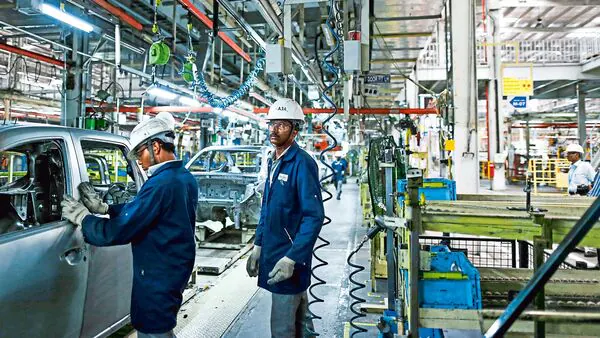
China-Led Magnet Imports More Than Halve. Automakers See No Turning Back
NEW DELHI: The import of permanent magnets, primarily sourced from China, more than halved in the first six months of the financial year 2026 due to Beijing's export restrictions and Indian automakers beginning to permanently shift away from heavy rare earths.
Imports of finished and unfinished permanent magnets, which are largely made of rare-earth metals, fell to 16,281 tonnes during the April to September period, registering a 56% drop from a year earlier, according to the ministry of commerce data.
That's the steepest fall in a six-month period in the last seven years. In the financial year 2025, the inbound shipments of such magnets grew 83% to nearly 53,000 tonnes.
Still, 88% of all permanent magnet imports came from China in the first half of the fiscal year, reemphasizing the country's near monopoly on the global supply chain.
Also Read | Cabinet approval for ₹7,300 cr rare earth magnet scheme expected within a moWhile a gradual shift to light rare-earth magnet imports cushioned Indian automakers, imports are expected to pick up from the second half as the Chinese government has started granting applications of Indian firms for heavy rare earths.
Automobile manufacturers are among the largest users of rare earth magnets, which are a crucial component in electric vehicle motors and other electronic components of a vehicle. Commentary from some of the top auto industry executives over the past month suggests that a permanent shift away from heavy to light rare earth is underway.
“Over the past few months, many companies have turned to alternatives such as light rare earth magnets, which has helped them cushion the blow," Hemal N Thakkar, senior practice leader & director at Crisil Intelligence, an industry analytics firm.“Companies have also started working on non-rare earth magnet motors, which reflects the decision that there's no turning back now on derisking supply chains for such components."
Rakesh Sharma, executive director at Bajaj Auto Ltd, which turned to light rare earths to resolve production issues, said during a post-earnings call with media on 7 November that the company has learned its lessons from the rare-earth crisis.
Also Read | TVS continues to flag rare-earth crisis, hopes GST reforms to boost H2 sa“Once having experienced this...and we actually got punished a little bit more because we were on a higher growth trajectory and demand was far ahead of supply and we were playing a catch-up game in any case...so we really stumbled on it," Sharma said.“So, I think one learning which we have taken is that we have to broad-base and de-risk our supply chain."
The country's fourth-largest two-wheeler maker is now looking to introduce ferrite magnets in its scooters to cut dependence on China–like Ola Electric Ltd, which has received approvals for a ferrite motor scooter.
Auto component maker Sona Comstar, one of the largest suppliers of traction motors used in vehicles, has also indicated that the company has begun altering its supply chain.
“In response (to the rare-earth crisis) what we did was we shifted to alternative motor designs that do not rely on heavy rare-earth magnets," said Vivek Vikram Singh, managing director and group chief executive officer at Sona Comstar.“So now we also manufacture our motors using light rare-earth magnets, and in this quarter, we have also successfully developed, tested, and validated a rare-earth-free Ferrite Assisted Synchronous Reluctance Motor."
Also Read | Why Indian carmakers are choosing the path of least Chinese resistaAccording to Singh, such motors will be a good solution for even three-wheelers and light commercial vehicles.
Electric scooter maker Ather Energy Ltd has incorporated light rare-earth materials, but is cautious about shifting to ferrite motors whose efficiency is yet to be proven in real-world scenarios.
Light rare-earth magnets can be a good alternative to heavy rare-earth magnets, as the supply chain is relatively diversified, Ather co-founder and chief executive officer (CEO) Tarun Mehta told Mint in an interview earlier.
“The industry has a way of moving past this (Chinese monopoly). Stop using heavy rare-earth magnets. Unlike cars, trucks, or buses, our industry can build motors without using heavy, rare-earth magnets," Mehta said.“We can move towards lighter, rare-earth magnets."
The government is also incentivising the shift. Mint reported on 22 November that the Union Cabinet is expected to approve a ₹7,300 crore rare earth magnet domestic manufacturing scheme within the next one month, with firms like Sona Comstar, JSW Group, and Bharat Forge, among others, showing interest.
However, all that will not immediately reduce India's reliance on Chinese rare-earth magnets.
As EV volumes increase, imports will continue to grow until alternatives are developed, which is at least a 2-3 year period, as it involves research, development, prototyping, testing and validation, said Crisil Intelligence's Thakkar.
Legal Disclaimer:
MENAFN provides the
information “as is” without warranty of any kind. We do not accept
any responsibility or liability for the accuracy, content, images,
videos, licenses, completeness, legality, or reliability of the information
contained in this article. If you have any complaints or copyright
issues related to this article, kindly contact the provider above.


















Comments
No comment